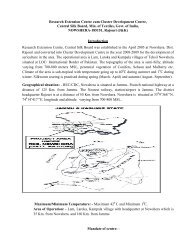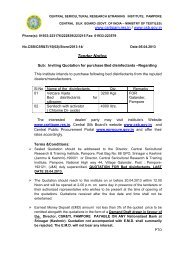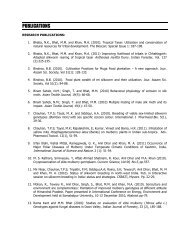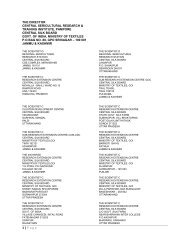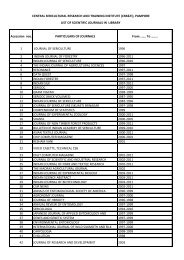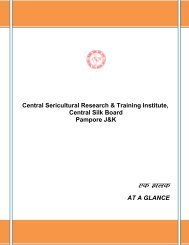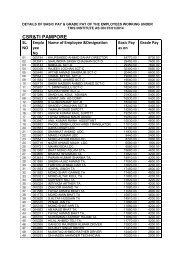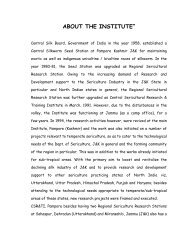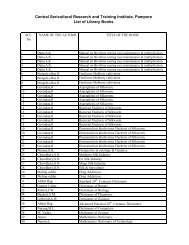Annual Report 2009-2010 - Central Sericultural Research ...
Annual Report 2009-2010 - Central Sericultural Research ...
Annual Report 2009-2010 - Central Sericultural Research ...
You also want an ePaper? Increase the reach of your titles
YUMPU automatically turns print PDFs into web optimized ePapers that Google loves.
¨ÉÖJªÉ ºÉƺlÉÉxÉ ¨Éå ÊxÉnäùÉEò b÷Éì B¨É B JÉÉxÉ ½èþ +Éè®ú nùÉä IÉäjÉÒªÉ +xÉÖºÉÆvÉÉxÉ EåòpùÉåù Vɨ¨ÉÚ B´ÉÆ ºÉ½þºÉ{ÉÖ®ú ¨Éå Gò¨ÉÉ: b÷Éì ¤ÉÒ ¤ÉÒ Ë¤ÉpÚù<br />
´ÉèYÉÉÊxÉEò b÷Ò B´ÉÆ ¸ÉÒ B¨É. B¨É. ¦É]õ ´ÉèYÉÉÊxÉEò b÷Ò EòÒ +vªÉIÉiÉÉ ¨Éå SÉ±É ®ú½þÉ ½éþ*<br />
About the CSR&TI<br />
CSR&TI, Pampore with its two Regional <strong>Sericultural</strong> <strong>Research</strong> Stations at Jammu and Dehradun<br />
and fifteen <strong>Research</strong> Extension Centres and one P4 Station at Manasbal provides<br />
need based <strong>Research</strong>, Development/Extension and HRD support to the states of North India<br />
viz., J&K, H.P., U.P., Uttarakhand, Punjab, Rajasthan and Haryana.<br />
With the primary aim to boost and revitalize the silk industry of J&K in particular and North<br />
India in general, the Institute has implemented a number of <strong>Research</strong> Programmes, which<br />
led to the development of region/season specific technologies resulting in increased productivity<br />
levels. Based on the ground realities, the Institute after consulting the active players<br />
engaged in Development of Silk Sector, developed a “Model” suitable for Development of<br />
Silk Industry in the North Western Region.<br />
The Institute at Pampore as a part of National responsibility maintains a rich germplasm of<br />
165 silkworm races; 67 mulberry genotypes and 80 mulberry genotypes of temperate origin<br />
at Manasbal, for conservation and utilization.<br />
Exchange of Scientific/Technical know-how for resource utilization and skill upgradation, the<br />
Institute and its regional stations have taken a number of collaborative projects with FRI,<br />
Dehradun; Indian Institute of Integrative Medicine (CSIR), Sanatnagar, Srinagar; <strong>Central</strong><br />
Soil & Water Conservation <strong>Research</strong> & Training Institute, Dehradun; Plant Medicinal Board,<br />
Lucknow/Dehradun and a number of Universities in North India.<br />
The Institute has a proper mechanism for research evaluation and monitoring system. At<br />
the Institute level, the in-house committee known as <strong>Research</strong> Council (RC) headed by the<br />
Director regularly discuss/review/ recommend the programmes of the Institute. RC is the<br />
recommendary committee to <strong>Research</strong> Advisory Committee (RAC) of the Institute, which is<br />
presently headed by Dr. A. S. Shawl, Scientist-F, IIIM, (CSIR), Srinagar, with a number of<br />
eminent scientists and Directors of respective DOS’s as its members. The progress of work<br />
is finally reviewed in the <strong>Research</strong> Co-ordination Committee (RCC) of the <strong>Central</strong> Silk Board<br />
presently headed by Dr. V. L. Chopra, President National Academy of Agricultural Sciences,<br />
Delhi, Ex-Member Planning Commission, Govt. of India and National Professor, ICAR.<br />
The Institute is located at Gallander, Pampore at a distance of approximately 16 kms from<br />
Srinagar city on the Srinagar – Jammu National Highway. The nearest airport is Srinagar<br />
while as the nearest railway station is Jammu Tawi, which is at a distance of 300 km.<br />
The main Institute is headed by Dr. M. A. Khan, Director and the two Regional Stations at<br />
Jammu and Dehradun by Dr. B. B. Bindroo, Scientist-D and Shri M. M. Bhat, Scientist-D<br />
respectively.



